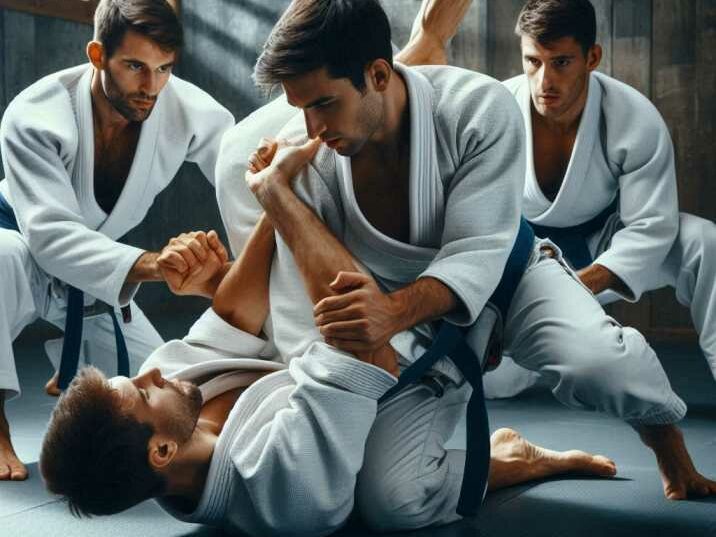Introduction
Table of Contents
Jiu Jitsu and Brazilian Jiu-Jitsu (BJJ) are often used interchangeably by those unfamiliar with martial arts. However, these disciplines, while related, have distinct histories, techniques, and philosophies. In this blog post, we’ll delve into the origins, key differences, and unique aspects of Brazilian Jiu-Jitsu vs Jiu Jitsu. Whether you’re a martial artist, a curious reader, or someone considering taking up a new hobby, this comprehensive guide will offer clarity and insight into the fascinating world of these two martial arts.

The Origins of Jiu Jitsu
Early History
Jiu Jitsu, often referred to as “the gentle art,” has a rich history that dates back to feudal Japan. It was developed as a method of close combat that warriors could use to defeat armed and armored opponents without weapons.
Samurai and Jiu Jitsu
The samurai, Japan’s warrior class, were instrumental in the development of Jiu Jitsu. They needed a way to defend themselves when disarmed, and Jiu Jitsu provided the necessary techniques. These techniques focused on joint locks, throws, and grappling, allowing a smaller, weaker fighter to defeat a larger, stronger opponent.
Evolution Over Time
Over the centuries, Jiu Jitsu evolved, incorporating various techniques from other martial arts. It became the foundation for many modern martial arts, including Judo, Aikido, and Brazilian Jiu-Jitsu.
The Birth of Brazilian Jiu-Jitsu
Introduction to Brazil
Brazilian Jiu-Jitsu traces its roots to the early 20th century when Mitsuyo Maeda, a Japanese Jiu Jitsu expert, immigrated to Brazil. Maeda taught the art to Carlos Gracie, who, along with his brothers, adapted and refined the techniques to develop what is now known as Brazilian Jiu-Jitsu.
The Gracie Family
The Gracie family played a crucial role in the development and popularization of BJJ. Helio Gracie, Carlos’ brother, modified traditional Jiu Jitsu techniques to suit his smaller frame, emphasizing leverage and technique over brute strength.
BJJ in Modern Times
Brazilian Jiu-Jitsu gained international recognition through the Gracie family’s challenge matches and the creation of the Ultimate Fighting Championship (UFC). Today, BJJ is practiced worldwide and is a staple in mixed martial arts (MMA) training.
Techniques and Styles
Techniques and Styles
Jiu Jitsu Techniques
Traditional Jiu Jitsu techniques encompass a broad range of skills, including striking, joint locks, throws, and defense against armed opponents. It is a comprehensive martial art designed for both standing and ground combat scenarios.
Brazilian Jiu-Jitsu Techniques
BJJ specializes heavily in ground fighting techniques and submissions. Practitioners focus on controlling opponents through positions like the guard and applying joint locks or chokes to force a submission. It emphasizes efficiency and technique over brute strength.
Key Differences
The key differences between Jiu Jitsu and Brazilian Jiu-Jitsu lie in their focus and application:
Training in Jiu Jitsu
Dojo Environment:
- Traditional Setting: Training typically takes place in a dojo, characterized by a formal atmosphere that includes bowing as a sign of respect and adherence to martial arts etiquette.
- Cultural Emphasis: Dojos often emphasize discipline, respect for instructors and fellow practitioners, and adherence to traditional martial arts values.
Curriculum:
- Comprehensive Approach: Jiu Jitsu training covers a wide range of techniques aimed at self-defense in various scenarios.
- Techniques: Includes striking techniques (punches, kicks), joint locks (wrist, elbow, shoulder), throws (nage-waza), and defense against weapons (tanto-dori, katana-dori).
- Variety of Skills: Students learn both standing and ground techniques, preparing them for diverse combat situations.
Belt System:
- Progression: Similar to other traditional martial arts, Jiu Jitsu uses a colored belt system to indicate a practitioner’s rank and progression.
- Hierarchy: Beginners start with white belts and progress through various colored belts (e.g., blue, purple, brown) before achieving black belt status, signifying mastery and advanced skill.
Training in Brazilian Jiu-Jitsu
Academy Environment:
- Relaxed Atmosphere: BJJ academies often have a more informal setting compared to traditional dojos, fostering a community-oriented environment.
- Practical Focus: Training primarily focuses on the practical application of techniques in grappling and ground fighting scenarios.
Curriculum:
- Specialization: BJJ training is specialized in ground techniques and submissions.
- Core Techniques: Emphasizes positions like guard (closed guard, open guard), mount, and back control, along with submissions such as armlocks, chokes (rear-naked choke, triangle choke), and joint manipulations.
- Live Sparring (Rolling): Integral part of training where practitioners apply techniques against resisting opponents, testing their skills and strategies in real-time.
Belt System:
- Progression and Recognition: BJJ uses a belt system ranging from white to black, with each belt level requiring dedication and proficiency in technique.
- Stripes: Stripes are awarded on belts to signify progress within each level, indicating increasing skill and understanding of BJJ principles.
Common Training Practices
Drilling:
- Repetition: Practitioners drill techniques repeatedly to build muscle memory and improve technique proficiency.
- Structured Training: Involves practicing specific techniques or sequences under the guidance of an instructor, focusing on correct form and execution.
Sparring:
- Live Practice: Sparring sessions involve applying techniques learned in drills against a live, resisting opponent.
- Development of Timing and Strategy: Helps practitioners develop timing, strategy, and the ability to adapt to different opponents and situations.
Conditioning:
- Physical Fitness: Both Jiu Jitsu and BJJ place importance on physical conditioning for overall fitness and performance.
- Components: Training includes strength exercises, flexibility drills, and endurance training tailored to enhance martial arts-specific attributes.
Philosophical Differences
Jiu Jitsu Philosophy
- Self-Defense: Emphasizes practical self-defense techniques.
- Mental Discipline: Focuses on mental strength, discipline, and respect.
- Holistic Approach: Incorporates various aspects of combat, including striking, grappling, and weapon defense.
Brazilian Jiu-Jitsu Philosophy
- Efficiency: Emphasizes the most efficient techniques for controlling and submitting an opponent.
- Adaptability: Encourages adaptation and problem-solving in dynamic situations.
- Community: Strong sense of community and camaraderie among practitioners.
Competitive Aspects
Jiu Jitsu Competitions
- Rules and Formats: Vary widely, may include striking, throws, and grappling.
- Traditional Tournaments: Often emphasize the art’s historical techniques and principles.
Brazilian Jiu-Jitsu Competitions
- IBJJF Tournaments: Governed by the International Brazilian Jiu-Jitsu Federation, with specific rules and weight classes.
- Submission-Only Events: Focus on submissions without points, rewarding technical proficiency and finishing ability.
- MMA: BJJ is a crucial component of mixed martial arts, with many fighters holding BJJ black belts.
Key Differences
Jiu Jitsu Competitions
Jiu Jitsu competitions vary in their rules and formats but typically encompass a broader range of techniques compared to Brazilian Jiu-Jitsu:
- Techniques: Jiu Jitsu competitions can include striking techniques, throws, standing grappling, joint locks, and submissions. This reflects its comprehensive approach to self-defense and martial arts training.
- Rulesets: Depending on the tournament, rules may allow for a variety of techniques, emphasizing both striking and grappling. Traditional Jiu Jitsu tournaments often maintain a broader scope of allowable techniques to showcase the art’s historical roots and practical applications.
- Scoring: Points are awarded for various techniques, such as takedowns, sweeps, and submissions, which contribute to a fighter’s overall score. Matches can be won by points, submission, or referee decision.
Brazilian Jiu-Jitsu Competitions
Brazilian Jiu-Jitsu competitions are governed by organizations like the International Brazilian Jiu-Jitsu Federation (IBJJF) and focus primarily on ground fighting and submissions:
- Grappling and Submissions: BJJ tournaments emphasize ground fighting techniques, where competitors seek to control their opponent using positions like the guard, mount, or back control, and secure submissions such as joint locks or chokes.
- Points System: Matches are often scored based on positional dominance and submission attempts. Points are awarded for achieving advantageous positions (e.g., mount, back mount) and for submission attempts that do not finish the match.
- Submission-Only Events: Some BJJ competitions, especially in submission-only formats, prioritize finishing techniques over points. These events encourage a focus on technical proficiency and the ability to secure submissions against skilled opponents.
Summary of Differences
- Scope of Techniques: Jiu Jitsu competitions encompass a broader range of techniques, including strikes and standing grappling, reflecting its comprehensive self-defense approach. In contrast, Brazilian Jiu-Jitsu competitions specialize in ground fighting and submissions, emphasizing positional control and submission techniques.
- Sport Orientation: While both martial arts have competitive aspects, BJJ competitions are highly focused on ground techniques and submission grappling, influenced by its evolution as a sport within the MMA context and its specific rulesets designed to promote technical proficiency and fair competition.
Cultural Impact
Jiu Jitsu in Popular Culture
- Movies and Media: Often depicted in samurai films and historical dramas.
- Martial Arts Influence: Foundation for many modern martial arts, including Judo and Aikido.
Brazilian Jiu-Jitsu in Popular Culture
- MMA Influence: Integral to the development and success of mixed martial arts.
- Celebrity Practitioners: Many celebrities and athletes practice BJJ, increasing its visibility and popularity.
- Documentaries and Films: Highlight the history and techniques of BJJ, such as “Choke” and “Jiu-Jitsu vs. The World.”
Table of Information About Brazilian Jiu-Jitsu vs Jiu Jitsu
| Topic | Jiu Jitsu | Brazilian Jiu-Jitsu (BJJ) |
|---|---|---|
| Origins | Developed in feudal Japan for close combat. | Adapted and refined from Jiu Jitsu in Brazil. |
| Early History | Samurai influence; defense against armed opponents. | Mitsuyo Maeda to Brazil; Gracie family development. |
| Training Environment | Formal dojo setting; emphasizes respect and tradition. | Relaxed academy atmosphere; community-oriented. |
| Curriculum | Broad; includes striking, joint locks, throws, weapon defense. | Specializes in ground techniques, submissions. |
| Belt System | Colored belts signify rank and progression. | White to black belts; stripes for progression. |
| Training Practices | Drilling, sparring, conditioning. | Emphasizes live sparring (rolling); technique drills. |
| Philosophy | Self-defense, mental discipline. | Efficiency, adaptability, community. |
| Competitions | Broad range of techniques; may include strikes. | Ground fighting focus; points for dominance, submissions. |
| Cultural Impact | Historical foundation for many martial arts. | Integral in MMA; popular culture presence. |
| Specialization | Versatile combat skills; broader scope of techniques. | Ground control, submissions; specific techniques. |
| Popularity | Global practice; historical roots in Japan. | Worldwide recognition; influenced by MMA. |
Conclusion
While Jiu Jitsu and Brazilian Jiu-Jitsu share a common ancestry, they have evolved into distinct martial arts with unique techniques, philosophies, and cultural impacts. Jiu Jitsu offers a comprehensive approach to self-defense, incorporating striking, grappling, and weapon techniques. In contrast, Brazilian Jiu-Jitsu specializes in ground fighting and submissions, with a strong emphasis on efficiency and adaptability.Whether you are drawn to the traditional aspects of Jiu Jitsu or the practical, sport-oriented approach of Brazilian Jiu-Jitsu, both martial arts offer valuable skills, mental discipline, and a sense of community. By understanding the differences and appreciating the unique aspects of each, you can make an informed decision about which martial art best suits your interests and goals.
FAQs
1. What is the main difference between Jiu Jitsu and Brazilian Jiu-Jitsu?
The main difference lies in their focus: Jiu Jitsu is a comprehensive martial art that includes striking, grappling, and weapon defense, while Brazilian Jiu-Jitsu specializes in ground fighting and submissions.
2. Can Brazilian Jiu-Jitsu be effective in self-defense?
Yes, Brazilian Jiu-Jitsu is highly effective in self-defense, particularly in situations where the fight goes to the ground. It teaches techniques to control and submit an opponent, regardless of size.
3. How long does it take to earn a black belt in Brazilian Jiu-Jitsu?
Earning a black belt in BJJ typically takes 10-15 years of dedicated training, though this can vary based on the individual’s commitment and skill level.
4. Is Jiu Jitsu suitable for all ages and fitness levels?
Yes, Jiu Jitsu can be adapted for practitioners of all ages and fitness levels. Its techniques can be modified to suit individual capabilities, making it accessible to everyone.
5. What should I look for in a Jiu Jitsu or Brazilian Jiu-Jitsu school?
Look for qualified instructors, a friendly and safe training environment, and a curriculum that matches your interests and goals. It’s also important to visit the school and observe a class to ensure it meets your expectations.


